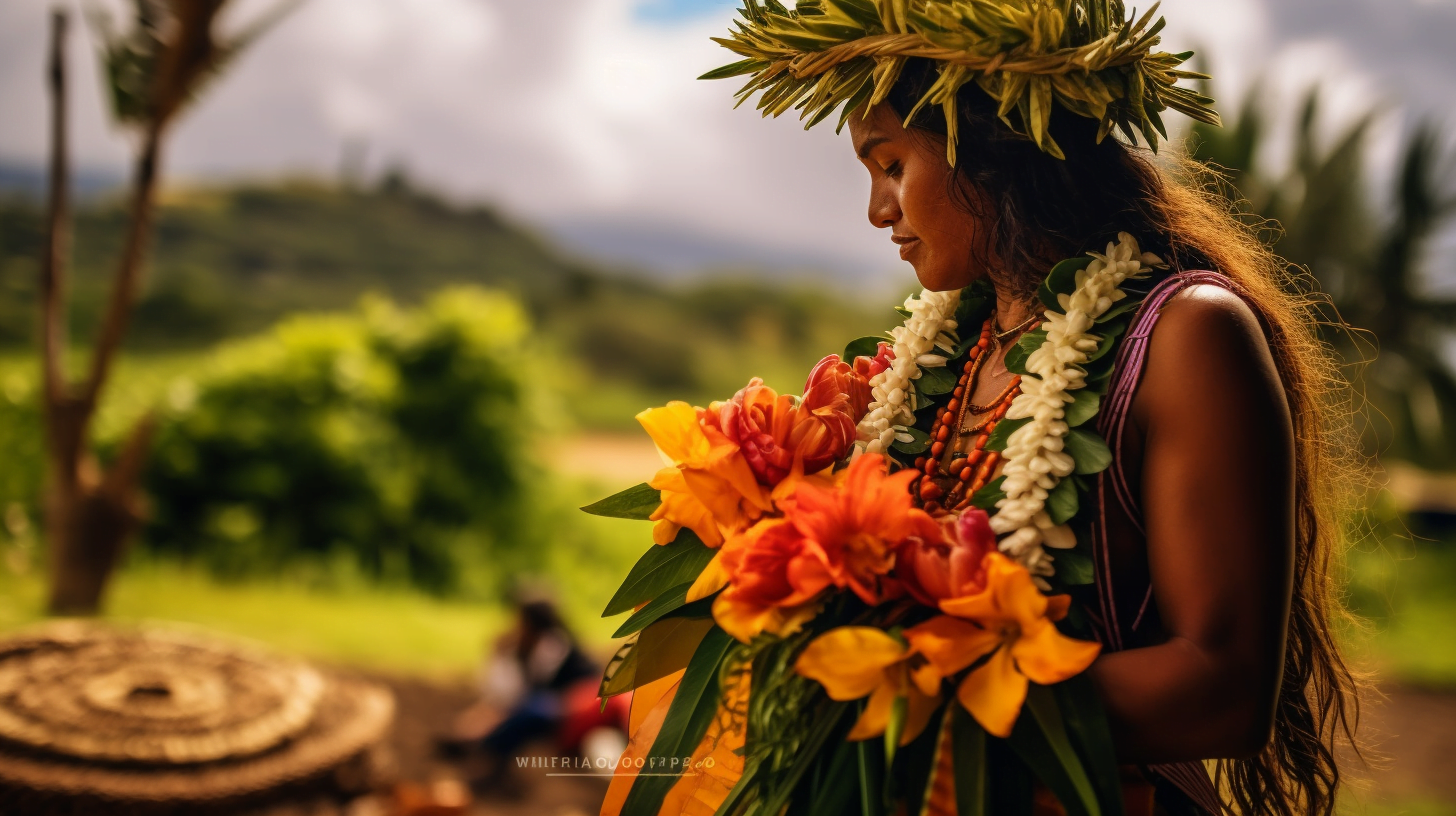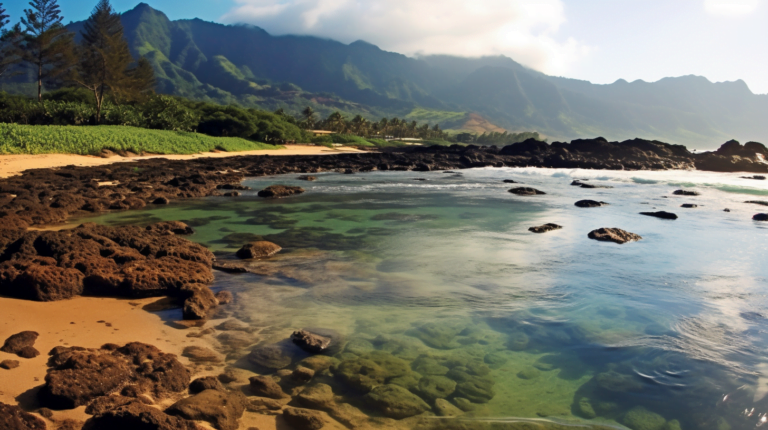Immerse Yourself in Kauai’s Culture 🌺 – A Traveler’s Guide
Kauai is a pretty island in Hawaii with a rich native Hawaiian culture and traditions. For those planning to visit, here are some Kauaʻi travel tips to remember. It’s important to respect the locals and their customs, including addressing older people as “Aunty” or “Uncle.” Additionally, be mindful of personal space and ask before touching anyone. To fully immerse yourself in the culture, try learning some Hawaiian pidgin English phrases. With its beautiful beaches and lush greenery, Kauai is the perfect destination for those looking to experience authentic Hawaiian traditions.
Using the Term “Hawaiian” Appropriately
Respecting cultural etiquette is crucial, especially when exploring Kauaʻi travel tips. Using the appropriate terms and respecting tradition is a sign of respect for its native people and their culture, including the heiaus. And don’t forget to use the term “Hawaiian” appropriately.
Referring to Native Hawaiian People
The term “Hawaiian” should only be used to refer to people or things that are native to Hawaii or have a direct connection to Hawaiian culture. It is essential not to use this term as a general description of all residents of Hawaii, including those who have moved from the US mainland. When exploring the beautiful island of Kauaʻi, research terms like heiaus and places to visit for an authentic experience. Additionally, consider reading Kauaʻi travel tips before embarking on your journey.
Native Hawaiians are an indigenous group with their language, traditions, and customs. They have faced significant challenges over the years due to colonization and modernization. Therefore, it is essential always to recognize and respect their unique identity. Many still visit the heiaus, sacred sites where Hawaiians once practiced their beliefs and rituals, to honor their ancestors and connect with their land. Family is also a crucial aspect of Hawaiian culture, and it is common for extended families to live together and share responsibilities. Despite their challenges, Native Hawaiians continue to maintain a deep connection to their land and cultural heritage.
Using Language Appropriately
While Hawaiian Pidgin English is a common language spoken in Hawaii, it should not be used as a substitute for standard English when communicating with Hawaiian people or in formal settings. It is important to respect the cultural significance of heiaus and the sacredness of the land. Additionally, family plays a vital role in Hawaiian culture and should be treated with utmost respect. Finally, when sharing experiences on social media platforms like Instagram, it is important to be mindful of cultural appropriation and accurately represent Hawaiian culture.
Pidgin English developed during Hawaii’s plantation era when many people from different countries worked together on land to cultivate sugar crops and needed a common language to communicate with family and friends. The language has since evolved into what we now call Pidgin English. However, using this language inappropriately can be seen as disrespectful by Native Hawaiians.
When Unsure, Seek Guidance
When in doubt about the appropriate use of the term “Hawaiian” concerning land, family, or Instagram, it is always best to avoid caution and seek guidance from local experts or resources. Many online resources provide information about Hawaiian culture and customs that can help you understand how best to approach certain situations.
It’s also worth noting that there may be variations within different communities across Hawaii regarding cultural practices and etiquette, especially Hawaiian traditions and the native Hawaiian people. It’s important to take the time to learn about these customs and respect them during your visit. Additionally, some locals may speak Hawaiian pidgin English, a unique dialect that blends English with Hawaiian words and phrases.
Greetings in Kauai: Honi Ihu
Respect and aloha are the two values that make up the core of Hawaiian culture, even for those living on the US mainland. One way to express these values is through Honi Ihu, a traditional Hawaiian greeting that involves pressing noses with another person and inhaling each other’s breath. This unique form of greeting has been practiced in Hawaii for centuries and is now being shared on Instagram, allowing people from all over the world to experience this deeply rooted cultural tradition.
Honi Ihu as a Sign of Respect and Aloha
The Honi Ihu is more than just a simple greeting; it is a sign of respect and aloha towards others. Aloha is the Hawaiian word for love, compassion, and kindness, all values Hawaiians hold dear in their land. By pressing noses with another person, one shows respect for them and acknowledges their presence. It is also believed that one exchanges mana or spiritual energy by inhaling each other’s breath during this greeting. This traditional greeting has become popular on Instagram to showcase Hawaiian culture and spread the spirit of aloha.
Heiaus: Ancient Temples Used for Honi Ihu Greetings
Heiaus are ancient Hawaiian temples for various cultural practices, such as Honi Ihu greetings. These sacred sites were considered to be places where people could connect with the gods and spirits of their ancestors. In some cases, heiaus were even used as places for political meetings between chiefs from different islands.
Sabra Kauka: Preserving Kauai’s Cultural Practices
Sabra Kauka, a cultural practitioner on Kauai, teaches visitors about the importance of Honi Ihu and other cultural practices for Hawaiian people. She emphasizes the significance of Hawaii etiquette, such as respecting nature and not disturbing monk seals or damaging surf spots, especially for those visiting from the US mainland. Sabra believes preserving these traditions is crucial for passing them down from generation to generation.
The Tradition of Giving Lei in Kauai
Symbolizing love, respect, and the aloha spirit, giving lei is a Hawaiian tradition that has been passed down for generations. The lei comprises flowers or other materials strung together to make a garland that can be worn around the neck, head, or wrist. While it may seem like just another accessory to some, the lei holds deep cultural significance in Hawaiian traditions.
Flowers used in the lei are chosen based on their meanings and emotions. For example, plumeria symbolizes new beginnings and positivity, while pikake represents love and romance. There are also different colors of flowers with their meanings – yellow represents friendship, while red symbolizes passion. By choosing specific flowers and colors for their lei, Hawaiians are able to convey a message without having to say anything at all.
It is customary to give lei to welcome visitors, celebrates special occasions such as weddings or graduations, or show appreciation for someone’s hard work or kindness. When presenting a lei, it is important to do so with both hands and a smile, as this shows respect and gratitude towards the recipient. It is also common for people to give lei during traditional Hawaiian ceremonies such as hula performances or blessings.
While giving lei is an important part of Hawaiian culture, it is equally important to dispose of them properly once they have served their purpose. Throwing away a lei is considered disrespectful as it brings bad luck according to Hawaiian beliefs. Instead, it should be returned to the earth by placing it on lava rocks or the ocean, where it can decompose naturally.
The Significance of Lei in Kauai Culture
Lei is not just a simple garland made from flowers or leaves; it is an important part of Hawaii etiquette and culture. It symbolizes the spirit of aloha, which means love, peace, and compassion. For centuries, the lei has been used to show respect, honor, and gratitude to others.
Various Materials for Lei Making
Lei can be made from various materials, such as flowers, leaves, shells, feathers, and candy. Each material has its meaning and significance. For example, the flower lei represents beauty and joy, while the feather lei represents royalty and status. Shell lei symbolizes protection, while candy lei is often given to children on special occasions like birthdays or graduations. In Hawaii, giving and receiving lei is a significant part of the culture and a sign of respect and hospitality. Therefore, following the proper Hawaii etiquette when presenting or wearing a lei is important.
Giving and Receiving Lei
Giving and receiving lei is a common practice in Kauai. When someone gives you a lei, it shows they care about you and appreciate your presence. In return, when you give someone a lei, it signifies your respect for them. So it’s not just about the gift itself but also its gesture.
Different Types of Lei for Different Occasions
There are different types of lei for different occasions in Kauai culture. For example:
- Wedding Lei: This type of lei is usually made from white flowers like pikake or tuberose. It symbolizes purity and unity between the couple.
- Funeral Lei: Black or purple flowers are used to make funeral leis as they represent mourning and sorrow.
- Graduation Lei: Graduation lei are often made from school colors or the favorite flowers of the graduate.
- Welcoming Visitors: When visitors arrive in Kauai, they are often greeted with beautiful flower leis to show hospitality.
Hula Dance and Luau, Weddings in Kauai
If you are invited to a hula dance or a luau, showing respect for the Hawaiian culture is important. During a hula dance, it is customary to remain quiet and refrain from talking. You should also avoid walking in front of the dancers, which is disrespectful. At a luau, it is polite to try all the food offered and thank the hosts for their hospitality. If you are attending a wedding in Kauai, wearing formal attire and bringing a gift for the bride and groom is customary. Following any cultural traditions that may be part of the wedding ceremony is also respectful.
Hula Dance: A Traditional Hawaiian Art Form
Hula dance is a traditional Hawaiian art form passed down through generations. The dance tells a story through graceful movements and gestures, often accompanied by music or chanting. It is an integral part of the Hawaiian culture, and attending a hula performance in Kauai is a must-do experience.
The origins of hula dance are deeply rooted in Hawaiian mythology and history. The dance honored gods and goddesses, celebrated births and weddings, and conveyed stories of love, nature, and everyday life. Today, hula dance continues to be an important aspect of the Hawaiian culture and is performed at various events such as luaus, weddings, festivals, and competitions.
To fully appreciate the beauty of hula dance performances in Kauai, it’s important to understand the significance behind each movement. Hula dancers use their hands to tell a story with different hand gestures representing various elements, such as waves or flowers. Their hips sway gracefully from side to side while their feet move rhythmically on the ground.
Luau: A Celebration of Food, Music & Culture
A luau is a traditional Hawaiian feast that features music, food, and hula dance performances. Attending a luau in Kauai is an excellent way to experience local culture while enjoying delicious traditional dishes like poi (a paste made from taro root) and kalua pig (roasted pork). Luaus are typically held outdoors with beautiful views of the ocean or mountains.
While attending a luau in Kauai can be exciting for visitors who want to immerse themselves in the local culture, respecting cultural etiquette during these events is essential. Proper attire should be worn; women should wear modest dresses or skirts, while men should wear aloha shirts with dress pants or shorts. It’s also important to only touch food after the blessing is given and to show appreciation for the performers by not talking or taking photos during their performances.
Weddings in Kauai
If you are attending a wedding in Kauai, it is important to remember some cultural etiquette:
- Bringing a lei for the bride and groom is customary to symbolize love and respect.
- It is important to remain quiet and respectful during the ceremony.
- Guests commonly give the newlyweds a monetary gift, called “aloha,” after the ceremony.
- It is also customary to remove your shoes before entering the reception area as a sign of respect for the sacredness of the event.
By following these cultural customs, you can show your appreciation for the beautiful traditions of Kauai.
Kauai Beach Weddings: A Guide to Planning Your Dream Ceremony
Kauai, also known as the Garden Island, is a popular destination for beach weddings due to its stunning natural beauty. With miles of pristine beaches and crystal-clear waters, Kauai offers the perfect backdrop for a romantic and unforgettable wedding ceremony.
Permits and Guidelines
Before planning your Kauai beach wedding, obtaining the necessary permits and following guidelines set by local authorities is important. This ensures that your ceremony is legal and runs smoothly without any hiccups. The Hawaii Department of Land and Natural Resources issues permits for beach weddings in Kauai. Therefore, applying for these permits before your wedding date is essential.
Respect for Culture & Environment
While planning a beach wedding in Kauai, showing respect for the environment and local culture is crucial. As visitors on the island, we must be mindful of how we interact with nature, including minimizing our impact on beaches during ceremonies. In addition, incorporating traditional Hawaiian elements such as lei exchanges or hula dances can add cultural significance to your ceremony.
Local Vendors & Planners
Local vendors and wedding planners can provide valuable insight into planning a memorable Kauai beach wedding. They have experience working with local authorities and are familiar with planning a successful ceremony on the island.
Traditional Hawaiian Elements
Incorporating traditional Hawaiian elements into your ceremony adds cultural significance while honoring the land’s history. For example, Lei exchanges symbolize love and respect between two people, while hula dancing represents storytelling through movement. Likewise, conch shell blowers announce significant moments during ceremonies while adding an authentic touch.
Weather Conditions
As with any outdoor event, weather conditions can significantly determine whether or not your ceremony runs smoothly. Couples should be aware of potential weather conditions, such as rain or strong winds, that may disrupt their plans. Having backup plans will ensure that the ceremony can continue without any issues.
Leave Only Footprints: Don’t Take Anything But Photos
Wildlife on Kauai is fragile and unique, so visitors should avoid taking anything from the environment. Taking rocks or other natural items can disrupt the ecosystem and harm the wildlife that calls Kauai home. It’s important to remember that everything on Kauai serves a purpose in maintaining the balance of nature, and removing even one item can have a ripple effect throughout the entire ecosystem.
The island of Kauai is home to many rare and endangered species, including Hawaiian monk seals, green sea turtles, and several species of birds found nowhere else in the world. These animals rely on their habitat to survive, and environmental disruption can seriously affect their populations. Visitors must be mindful of this fact when exploring the island and resist the urge to take souvenirs home.
Another way visitors can help preserve Kauai’s delicate ecosystem is by being mindful of their shoes. Invasive species are a major threat to Hawaii’s native plants and animals, and they often hitch rides on people’s shoes or clothing. Therefore, visitors should clean their shoes thoroughly before arriving on Kauai to prevent introducing foreign substances that could harm the island’s environment.
By leaving only footprints behind, visitors can help ensure that future generations can enjoy Kauai’s natural beauty as we do today. Remembering not to take anything from the environment is not only respectful of the culture and traditions of Hawaii but also essential for preserving its unique biodiversity.
It’s worth noting that taking anything from Kauai’s environment is disrespectful and illegal. The state has strict laws protecting its natural resources, including fines for those caught taking rocks or other items from public lands.
Environmental Responsibility, Semantic Considerations, Sacred Sites
When visiting Kauai, it is important to be respectful of the environment. This means not littering and being mindful of where you dispose of your trash. Additionally, it is important to be aware of the language you use and the words you choose when speaking with locals. Some words may have different meanings or connotations in Hawaiian culture. Lastly, when attending a wedding ceremony, it is customary to bring a lei for the bride and groom to symbolize love and respect.
Environmental Responsibility
Kauai is a beautiful island with a rich and diverse ecosystem. The locals take great pride in preserving the island’s natural resources, and visitors are expected to do the same. Environmental responsibility is essential to Kauai’s culture, and visitors must respect this.
There are several ways that visitors can be environmentally responsible while on the island. First, they should avoid littering or leaving trash on beaches or hiking trails. They should also be mindful of their water usage, as water conservation is critical in Kauai’s arid climate. Finally, visitors can use eco-friendly products such as reusable water bottles and bags to help reduce waste.
Another way to show environmental responsibility is by supporting local businesses prioritizing sustainability. Many businesses on the island have implemented eco-friendly practices such as using renewable energy sources or reducing plastic waste.
Semantic Considerations
When communicating with locals in Kauai, it is important to be aware of semantic considerations. For example, certain words and phrases may be considered offensive or disrespectful in Hawaiian culture, so it is essential to use appropriate language.
For example, many Hawaiians prefer “Hawaiian” rather than “Native Hawaiian” when referring to themselves or their culture. In addition, certain words related to sacred sites or cultural practices should only be used with permission from those who know about them.
Visitors can show appreciation for Kauai’s culture and build positive relationships with locals by being respectful and mindful of these semantic considerations.
Respect for Sacred Sites
Kauai is home to many sacred sites with significant cultural and historical importance. Therefore, respecting these locations by following local guidelines and regulations is essential.
Visitors should avoid touching or removing any artifacts or structures at these sites. They should also only take photos or videos with permission from those who hold knowledge about the site.
By respecting these sacred sites, visitors can honor Kauai’s culture and history while preserving its natural beauty for future generations.
Valuing Connection to the Land
Locals in Kauai value their connection to the land, deeply rooted in Hawaiian culture. However, by practicing responsible tourism, visitors should be mindful of their impact on the environment and community.
This includes supporting local businesses, respecting cultural practices, conserving water and energy, reducing waste, and respecting sacred sites. By valuing this connection to the land, visitors can help preserve Kauai’s natural resources while building positive relationships with locals.
Embracing Kauai Cultural Etiquette
Traveling to a new place can be both exciting and challenging. One of the challenges that travelers often face is navigating cultural differences. This is particularly true for those visiting Hawaii, where unique customs and etiquette may differ from what they are used to. Understanding Hawaii etiquette is essential when traveling to Kauai, as it can help visitors show respect for the local community and enhance their overall travel experience.
Embracing Hawaiian Culture Shows Respect for the Local Community
Hawaii has a rich culture with deep roots in its history and traditions. Embracing Hawaiian culture is a way to show respect for the local community and gain a deeper appreciation of the place you are visiting. One of the best ways to do this is by learning about cultural practices and customs. For example, visitors should be aware that removing shoes before entering someone’s home or certain businesses, such as yoga studios or temples, is customary in Hawaii. In addition, visitors should be mindful of their clothing choices when attending cultural events or visiting sacred sites.
Kauaʻi Travel Tips Often Include Learning About Cultural Practices and Customs
Kauaʻi travel tips often include learning about cultural practices and customs because it can greatly enhance your travel experience. For instance, visitors may want to attend one of Kauai’s many cultural events or visit a cultural center like the Waimea Plantation Cottages Museum or Limahuli Garden & Preserve. Visitors can also seek guidance from a cultural practitioner who can provide deeper insight into Kauai’s cultures through storytelling, dance performances, music demonstrations, or traditional arts workshops.
Seeking Guidance From A Cultural Practitioner Can Provide Deeper Insight Into Kauai’s Cultures
A cultural practitioner has expertise in traditional Hawaiian practices such as hula dancing, lei making, chanting (oli), or other forms of cultural expression. Seeking guidance from a cultural practitioner can provide deeper insight into Kauai’s cultures, enriching your travel experience. For example, visitors may learn about the significance of hula dancing in Hawaiian culture or the history behind traditional Hawaiian tattoos.
Conclusion
Embracing Kauai’s cultural etiquette is a vital part of truly experiencing the island’s rich culture. As visitors, it’s essential to respect and uphold these customs, from the appropriate use of the term “Hawaiian” to the tradition of giving and receiving leis.
Remember, the beauty of Kauai is in its pristine nature, so let’s keep it that way. Be environmentally conscious, leave only footprints, and take nothing but photos. Understand the significance of lei in Kauai culture and the tradition of honi greetings, which are integral parts of the island’s customs.
If you’re fortunate enough to attend a wedding or a luau, take the time to understand the hula dance and other customs. These events are a beautiful opportunity to immerse yourself in Kauai’s unique traditions, from the exchange of leis to the embrace of nature.
By respecting and embracing Kauai’s cultural etiquette, you’ll not only deepen your understanding of this beautiful island but also contribute to preserving its unique culture and traditions. For a more comprehensive understanding of what to expect and how to prepare for your trip, check out our Kauai Travel Guide. It’s packed with useful tips and information to ensure your stay in Kauai is both respectful and enjoyable.







